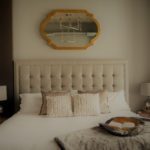Lighting is such a key part of a room design and yet is so often overlooked. Badly positioned wall sconces, dim reading lights and pendants you bash your head on are common mistakes in interior schemes.
It can be really hard before you have lived in a space to know where to place lighting and yet to get it right it needs to be one of the first things that you consider as it might mean re-wiring is required before renovations begin. There are lots of things to consider when planning your lighting arrangements. What will the room be used for? Is any task lighting required, ie, for cooking, reading, putting on makeup? Do you want to create a cosy atmosphere? Are you energy conscious (aren’t we all nowadays?)
Interior designers can come to your rescue here! Did you know they can complete a lighting survey to help you calculate how many lights you need, where and what type, ie, ceiling, wall, lamps. Designers, like myself, can use calculations to work out the number of lumens (watts) that are required from your bulbs (the higher the number the brighter the bulb) and how natural you want the light to look. A colder tone gives more light but can be stark, a warm white gives a good combination between cosy light with a decent brightness. This survey will give you a plan for how many lights are required and a reflected ceiling plan which you can use with your electrician and builder to work out what, if any, re-wiring needs doing. The plan will also help you source your light fittings (which of course your interior designer can help with too).
Nowadays there are many more options out there so that re-wiring isn’t necessarily the only option especially if you are on a budget. There are some great plug-in wall lights available which give you the flexibility of switching lights to suit your tastes as they change. There is also a trend to no longer worry about hiding the cable and rather make a feature of it with many woven braided cables on offer.
Interior designers can also help to extend the natural light available in a room too and will take that into account before layering with other lighting. And if you are wondering what layering lighting is, think of your ceiling and wall lights as the primary layer that give light where it is needed most. The second layer of lighting is for accent lighting for your tasks in the evenings (dull light) and includes floor lamps and bedside table lamps for reading perhaps. Finally, the third layer is for creating that ambience and mood, mini lamps on coffee tables and shelves. Of course, tricks such as adjustable arms on lamps and dimmable switches can also help to create the right lighting levels for what you need.
If you think you might need so help to get the lighting right in your room, get in touch and I can help.


